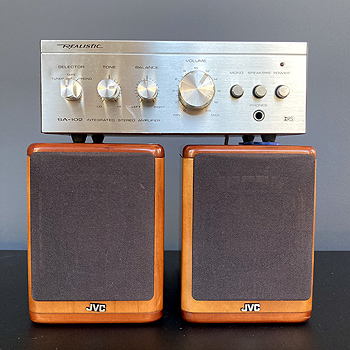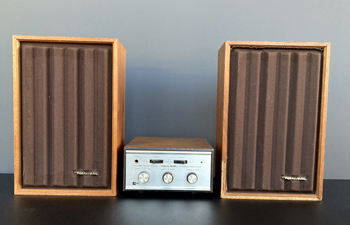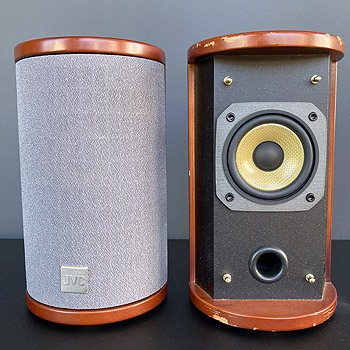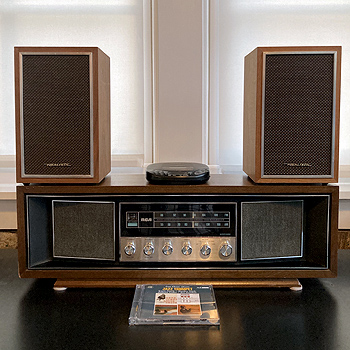For the past twelve years I have experienced a huge amount of enjoyment from experimenting with a wide variety of inexpensive component systems from the 1960s and 1970s. The smallest are certainly not anything that would even qualify as mid-fi, yet they can still impart a good deal of listening pleasure and they have lots of visual appeal. They certainly they work well for desktop audio, secondary systems in workshops, vacation homes or in other applications where both space and budget are limited. The better systems in this group can provide a reasonable quality listening experience that can be enjoyed on several levels.
For more serious applications where space is limited, many will want to leave these behind and journey to the 1980s when Japanese manufacturers such as Panasonic/Technics and Aiwa perfected high quality mini-systems just before the era of quality "silver" components came to an end. These are featured in our MAXIMUM PERFORMANCE section.
But if you have an adventurous spirit, consider the lowly and inexpensive audio gear that filled catalogs from Radio Shack, Lafayette Electronics, and Allied Electronics, to name just a few. These used mini-amplifiers with just a few watts of power or very low power receivers. The mini-speakers that were sold with them are certainly not comparable to modern full-range systems, but their single driver sonics can be quite appealing. And there’s certainly lots of retro appeal in their Mid-Century design and appearance. You can have a lot of fun with a budget of just $100-$250 for a system.
The late 1960s and early 1970s were truly the golden years for inexpensive low-fi components because there were so many people getting seriously involved with music who either couldn’t afford anything better or who loved the process of starting at the bottom and moving into a slightly better system every year or two. I started buying these systems in 1965 and stayed with them for 10 years until I got serious in 1975 and moved up to a pair of Advent speakers and a 30wpc power amp.
By the mid 1980s, as cassettes and later CDs soared in popularity, the large consumer electronics manufacturers found numerous ways to turn out cheap components that boasted tons of features and real power. Somewhere along the way the unique qualities that distinguished the early era of lo-fi got lost, leaving us with a huge variety of ugly components that were just one more example of disposable and soulless mass market merchandise.
The great audio catalog merchandisers from the 1960s all eventually bit the dust. Some were dearly missed. Others deserved to rest in peace. Brands that survived the longest, like Radio Shack’s Realistic, eventually became truly disposable third-world manufactured products with little to recommend them beyond their widespread easy availability. But while jokes about “Rat Shack” abound, Radio Shack, Allied and Lafayette Electronics were capable of offering products of decent quality, lasting value, and real appeal.
Fifty years after their heyday, you can still find a surprisingly large number of devoted collectors and enthusiasts who seek out the low-fi and mid-fi experience that many of my generation (who came of age just as stereo blossomed in 1955-1965) remember so fondly. We invite you to join us!
A CAUTION FOR VINYL ENTHUSIASTS
You will enjoy these systems with sources such as a CD player or any modern media system. The AUX and/or TUNER inputs do fine with these. If you want to do a good bit of listening to vinyl then you’ll have to be a bit more selective in choosing components. Some of the smallest systems often don’t have a phono input suitable for a magnetic cartridge and those that do usually have one that is sub-par.
If you have a bit more space and love the look of a wood or fake wood enclosures, then you will do a little better with the phono input stages on some of the low powered receivers and you will gets some decent FM radio as a bonus. These will be adequate for occasional listening to vinyl. For serious vinyl playback, you’ll need either a full-size mid-fi receiver or you’ll simply want to add an inexpensive and compact outboard preamp ($30-$60) like a Behringer PP400 or a Rolls VP29 (our favorite) to the compact mini-amps.
INTO THE LOW-END
To begin, there are systems that are strictly for novelty purposes where space is at a minimum and fidelity is not a major consideration. Realistic Minimus 0.3's were a tiny sealed 4” cube with a 3” driver and walnut veneer enclosure. They could be driven by most any small amplifier or even from some headphone jacks. The Minimus 0.5’s were a slightly larger version (6”x4”x4”) with a 4” driver and a bit fancier cabinet. These work well with low end amplifiers such as the Realistic SA-10 (black plastic cosmetics). Together you have an entry level mini-mini for about $40-$60. If you want retro cosmetics and a few watts of cleaner power you could spend a bit more and substitute a Realistic SA-101 or SA-102 amplifier.
All the catalogs from the late 60s and early 70s featured a number of entry level small amplifiers that they built their low-budget “starter” systems around. The only ones that I still favor and purchase are the Radio Shack Realistic brand.
They began with the very solidly built SA-100 which went through A, B and C models from 1968-1973. It had wooden end caps and nice simple mid-century cosmetics. Although it specs out with only around 3 wpc and doesn’t claim much response on the low end, I have found that it does quite a very nice job driving a variety of small speakers.
A few years later they added the SA-101 to the line. It added the capability for magnetic phono cartridges which the SA-100 lacked and a more useful tone control. While not unattractive, the cosmetic style is more transitional than Mid-Century with a partial black panel and a cheaper plastic appearance. It is noticeably lighter than than the SA-100 but it does put out a 3.5 wpc
It was followed in 1980 by the SA-102 which had beautiful silver-era cosmetics in a classic layout that echoed the styling of the more expensive components with a brushed aluminum front panel and polished metal-finished controls. The case had a nice fake vinyl veneer. The knobs and switches feel great but the amp is decidedly lightweight at less than 2 wpc. The size at 3.5”x9”x7” is also appealing and overall it look a bit more solid than it actually is .The tone control is pretty much useless. I love the look and feel of these amps but they perform well with only a few speakers so they are fun to own but relatively limited in their application.
The SA-175 is a decidedly different type of amplifier with barebones features and minimalist styling yet boasting performance that aimed at the mid-fi market and more serious listeners. Introduced in 1969 it went through A, B and C variations by 1972 and remained in the line until after 1975. It puts out a solid 6-7 wpc and drives a large variety of speakers well. We discuss the SA-175 amplifier at some length later in this section, because it really transcends the low-fi class and is one early Realistic amplifier that still commands respect and a decent asking price on the aftermarket.
LOW-FI SYSTEMS
Let’s consider some component systems that mark an acceptable entry point to the world of retro-mid-fi. These all came to market between 1970-1975. These systems all use Realistic amplifiers SA-100, SA-101 and SA-102 or the Realistic STA-16 and STA-21 or Allied 426 and 435 Receivers. At 2-7 real watts per channel all these pair well with efficient small speakers with 3”-5” drivers for a very nice single driver listening experience. There are some very attractive and surprisingly good small speakers available for these amplifiers. The receivers noted above look very smart and they have enough power to drive some small 2-way speakers to reasonable volume levels.
The least expensive and best looking mini-speakers are ones from JVC that were originally sold with their “executive systems” in the 1990s. The SP-FSSD9 and the SP-FSSD990 are the basic models with essentially the same small driver (D9 is a straight round cylinder, D990 is similar but with more sculptured shape). The JVC gem is a cubical speaker, the SP-UX7000, which features a more advanced driver and a stunning cherry wood cabinet. These have become a cult item, widely acclaimed in Internet posts with words like "amazing" and "astonishing." At $35-$55 per pair depending on condition, the SP-UX7000 are a benchmark bargain.
A bit larger in size, with their own traditional rectangular retro styling are the Realistic Minimus-8, sometimes branded as the Solo-8. These are single driver speakers featuring a 4” driver. The better ones, usually #40-2016A, have a Foster 103 speaker and the flashier models with metal trim, usually #40-216, have a similar driver that is not quite up to the Foster 103.
Realistic had two larger models -- the Solo-1 and the Minimus-4 -- which definitely have a classic look. The Solo-1 was Radio Shack’s first big hit beginning a 15 year run in 1960. It employs a single 6 inch driver in a 14”x11”x11” cabinet that embodies a Danish modern look. The sound is dated but pleasant. The Minimus-4 (#40-224) was a similar size but more rectangular with a unique brown sculptured grill for a more space-age look. It added a whizzer cone to the single driver and sounds surprisingly good.
The best single driver experience for low power mini-amps and receivers is the widely acclaimed Realistic Solo-103, which sometimes was branded as Solo-3. It is a very nice implementation of the Foster 103 driver and the older ones with Alnico magnets are quite special. The size (10”x6”x7”) and very cool retro appearance complement many systems. It can be driven by most any small amplifier in the Realistic line but it performs better with 5-15 wpc amps and small receivers.
Those wanting a larger 2-way speaker could pair the SA-100 and SA-101 or the receivers with Realistic’s later model Minimus-25 Speakers which feature a 5” woofer and a decent cone tweeter. Small 2 way mini-speakers like the Realistic Minimus-7 and Koss M60+ will also do OK with these although we usually would recommend that these speakers perform best when paired with 10-15 wpc amplifiers.
A unique small system that I favor is built around RCA’s RLC-75W FM stereo radio, a classic example of 1960s space age design. This radio features an auxiliary input that pairs well with CD players and media players. The internal speakers have a nice sound to them but this system really comes alive when you add some matching external speakers such as the Realistic Minimus-8. I have modified several of these radios adding with ¼” jacks for external speakers. Truly maximum fun! Sounds good, looks stunning.
INTO MID-FI
The most serious systems in this general class use Realistic’s SA-175 series amplifiers first introduced in 1969 as # 1-1973. They were rated at 12 watts IHF per channel over the full-range - likely about 6-8 watts per channel real power - enough to drive most small speakers very nicely. It does particularly well with Realistic Minimus-1 (the wood cabinet predecessor to the Minimus-7) or with Lafayette Electronics Criterion 25/25a, Realistic Minimus-25 or the Realistic MC500. The Minimus-1 and Criterion 25’s are both unusually attractive but when it comes to sonics, the Minimus-1 are the clear winners over all the others despite their small size.
The SA-175 boasted a most unusual appearance - they had only 3 knobs and 2 small rocker switches in a compact walnut veneer cabinet that measured 4” high by 7” wide by 10” deep. As you have likely guessed by now, these amps are a personal favorite of mine.
These are just a small sampling of ways to enjoy the low-fi components that made such a splash in the first half of the 1970s. We recognize, of course, that those with larger budgets and more available space might seek systems that provide a true mid-fi experience with wide ranging speakers.
Another inexpensive approach that appeals to some buyers were the mini-receivers that Realistic introduced at the end of the 1970s. Most of these featured the black high tech cosmetics that dominated consumer electronics in the late 1980s and 1990s but you can find silver models from time to time. The STA-7 was the first of what they called their slim-line receivers boasting about 10 wpc. By 1983 it evolved to the STA-700 with 12 wpc. It was a worthy companion to their Minimus-7 mini-speaker.
The more basic STA-12 from 1983 was called a personal receiver and perhaps was the smallest quality receiver ever marketed. It was a 5 wpc design without tone controls but had a loudness setting that shaped its response to provide excellent performance with the Minimus 7 speakers. For those wanting a more modern look in a truly miniature system, the STA-12/Minimus-7 combination provides a lot of value for a roughly $125 expenditure.
The first step upwards from all of the previous systems is getting more watts per channel. Our MAXIMUM PERFORMANCE section details the silver-era Japanese Mini-Systems that we have a great fondness for. Aside from these mini-components which briefly flourished in the 1980s, there were a number of excellent small integrated amplifiers and many good receivers that graced dealer shelves in the 1970s. We invite you to next visit the BUDGET SILVER ERA COMPONENTS pages on this website for a discussion of these.
The Fine Print:
A note to our readers: Of course, the above conversation does not claim to be a comprehensive review of the entire low-fi & mid-fi landscape. It simply reflects my personal listening experiences with the gear that I have enjoyed since I began this project in 2008. Pricing mentioned in these discussions is to be taken as a useful reference but they are not to be taken as actual selling prices. The prices shown on the EQUIPMENT FOR SALE pages of this website are actual selling prices but any other prices on the website are strictly for general reference and should always be updated by way of a request to us for a formal quotation.
When I started buying up vintage low and mid-fi gear In 2008, prices were low and bargains were easy to find. As the vinyl revival progressed, interest in these components revived and word began to spread about some of the outstanding ones. Internet forums have contributed to a vigorous after-market. Many more sellers are responding to the increasing demand and raising their prices. My reference and selling prices all are based on what I paid for current inventory. Once that inventory is sold, it is quite likely that future prices for most items will increase due to the rising costs of new acquisitions.

JV SPK-FSSD990 & Realistic SA-101 Mini System.jpg

JVC UX7000 Realistic SA-102 Mini System

Realistic SA-100 & JVC SP-FSSD

Realistic SA-175 & Minimus-4

JVC SP-FSSD9 #2

JVC SP-UX7000 #2

SA-175-2

